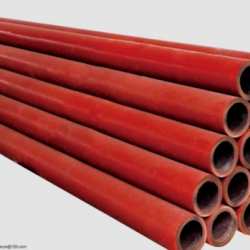Since China's reform and opening up, with the rapid development of the economy and the enhancement of the concept of environmental protection, the use of pipeline media transportation in modern industrial production has increased significantly, while the situation of large wear, heat and corrosion has always plagued industrial development and environmental governance. . In the 1990s, the wear-resistant ceramic composite steel tube successfully developed by Beijing University of Science and Technology solved this problem and filled the blank of traditional material transportation in domestic industrial production. In 1994, the invention products passed the product appraisal of the Ministry of Metallurgy and the Ministry of Electric Power. [Ministry of Metallurgy, 93 Metallurgical No. 372], and [Electricity Department 94, Electric Power, No. 30] were listed by the National Science and Technology Commission. The five-year Torch Program is a key support and promotion project for the national “863” high-tech materials.
Process and performance Wear-resistant ceramic composite pipe consists of ceramic layer, transition layer and steel pipe from inside to outside. Manufacturing process: the high-purity mixed reaction material is filled in the steel pipe and fixed in the centrifuge. The centrifuge rotates at a high speed to ignite the reaction material under the action of centrifugal force, and the molten alumina above 2600 °C is uniformly and firmly bonded to the inner wall of the steel pipe. A dense and smooth corundum ceramic layer is formed, which has a Mohs hardness of 9.0, which is equivalent to HRC90 or above, and can be used normally for a long period of time in the range of working temperature -50 °C - +900 °C.
Features and uses
Wear-resistant ceramic composite pipe is characterized by high bonding strength, abrasion resistance, high temperature resistance and strong corrosion resistance. After long-term use by the user, it proves that the service life of the product is 8-10 times that of the seamless pipe, which is 5 times that of the alloy steel pipe and the cast stone pipe, and the running resistance of the conveying material is small. Can be widely used in electric power, metallurgy, coal, mining and other industries, such as: power plant boiler powder feeding elbow, ash slag pipeline, steel plant blast furnace waste gas, water slag, sintering head, tail dust removal pipeline, coal mine heavy medium selection Coal pipelines, mine backfilling, material conveying pipelines, etc. are the most ideal medium conveying pipelines under harsh environmental conditions.
Cost and installation
The wear-resistant ceramic composite pipe has the characteristics of high hardness, compactness and light weight, which changes the traditional pipe depending on the thickness and prolongs the service life. The wear-resistant ceramic composite pipe and the cast stone pipe have the same engineering cost, which greatly facilitates the site. Installation speeds up the construction schedule, thus reducing the user's transportation, support, lifting and construction costs. The mounting method can be flanged, quick joint and field welding.
· Avoid serious collisions during transportation, lifting, and installation. In particular, avoid metal devices directly hitting the ceramic layer on the end face.
· When installing on-site pipelines, the pipelines and pipelines should be centered, and the height should be leveled to ensure accurate contact at both ends.
· When welding the flange on site, the flange surface must be flush with the end face of the pipe.
· On-site welding of pipes and fittings, 60°V-type groove with lathe processing at both ends of the factory, the butt joint is tight, and welding should adopt small current.


